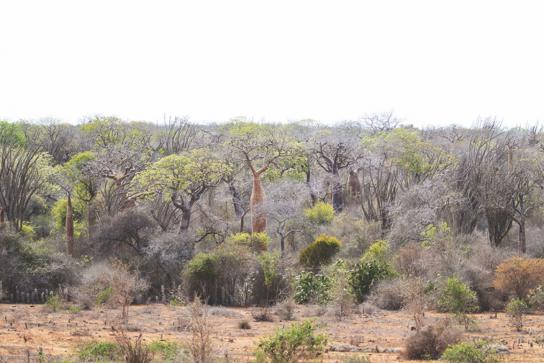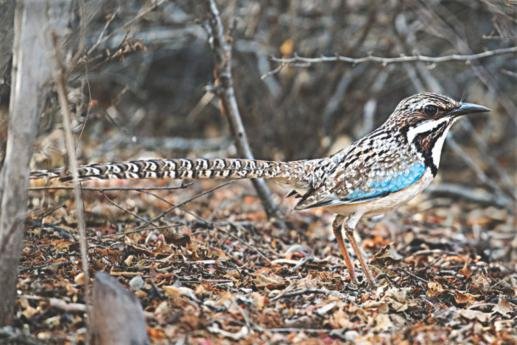The Spiny Forest

In the south of Madagascar near the town of Toliara lies one of the most unusual places I have visited. Spread over dry, arid, sandy land are forests punctuated by giant baobab trees with massive trunks that look like bottles. However, something is different: these are not dense green forests. Instead, they are thickets of dry, spiny, thorny plants dominated by many species not found elsewhere in Madagascar, let alone the rest of the world.
Residing among the spiny forest are species of unusual and rare birds, as well as reptiles, lemurs and tortoises. At the entrance of the forest, as our group awaited the guide (an absolute necessity since most birds and animals here hide very well), we hear flapping wings and look overhead to find a motley of weaver bird nests hanging from a tree. The birds – sakalava weavers, one of two species of weavers in Madagascar – look not too different than our babui (baya weavers.) But their messy nests appear to be constructed ad hoc, as opposed to the exquisite well-constructed homes of baya weavers.
Walking along the sandy path through the forest we first encounter several smaller birds before a familiar sight – the Madagascar hoopoe. It looks quite similar to our hoopoe (mohonchur) but it is a different species: it is larger, with a longer tail and a different call.
Further up the trail we encounter one of the prized inhabitants of this strange land. Scampering back and forth underneath the dry bushes is a bird that spends all its time on the ground, running from ants to worms to cockroaches. At first glance, its long tail is the only distinctive feature of the otherwise bland, grey and white bird. But then it turns around and I see its claim to fame – a splash of delicate powdery blue on its wings. We have found the long-tailed ground roller, one of the rarest birds in the world.
Long-tailed ground roller. Photo: Ihtisham Kabir
Birds from two other families can also be found here: the vangas and the couas. These families of birds are only found in Madagascar. While the couas are colourful and fast-moving, my favourite is the sickle-billed vanga with a most unusual bill shaped like a sickle.

I mentioned the subdesert mesite in my previous column, but another encounter I enjoy is with a Madgascar sparrowhawk. As I stand underneath the large tree - where it is perched, high up - and aim my camera towards it, it swoops down straight at me, veering upward at the last minute to land on another branch, from which it again flies towards a third branch. As it flies above me, I can see the perfect rows of thin black stripes the entire width of its bottom from wingtip to wingtip. “Now you tell me!” I exclaim as the guide points out that it is defending its nest high up on the tree.
Not to be outdone, many kinds of reptiles – lizards, skinks, chameleons - also put on a show. Our guide grabs a small snake that was slithering by and dangles it while we take photographs. In Madagascar you can be brave with snakes because they are all non-poisonous.
The arid but vibrant beauty of spiny forest returns often to my mind, like a recurring dream.